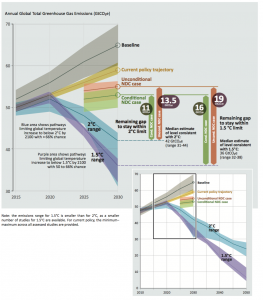Conversation on the causes and scope of climate change this week with an examination of the UN Emissions Gap Report 2017. The theme of the week: Urgency.
As described in the figure from the report below, to give the planet the best possible chance of limiting warming 2° or 1.5°C above pre-industrial levels, the world needs to peak and begin steadily declining greenhouse gas emissions in the next decade. This while emissions reached an all time high in 2018. Furthermore, emissions should continue a steady decline through 2050, hitting near-zero for the 1.5°C scenario. In fact, we will need to have some tricks up our sleeve, with the 2018 IPCC Report stating “All pathways that limit global warming to 1.5°C with limited or no overshoot project the use of carbon dioxide removal (CDR) on the order of 100–1000 GtCO2 over the 21st century.” For context, the world currently emits about 37 GtCO2 per year. The bottom line is that drastic reductions are needed in global greenhouse gas emissions, and there is no longer time to waste.

From (The Emissions Gap Report 2017)
Discussions in our first class centered around the scale of this problem and the need for countries (especially economically-developed countries with more than their fair share of historical emissions) to step up their emissions budgets, known as NDCs under the Paris Agreement (Nationally Determine Contributions). We also discussed hope, or lack thereof, on the issue. Having previously developed a framework for the projected climate impacts on global populations, we agreed there is no place for hopelessness – the fight must continue and its our responsibility to contribute. A final topic of conversation was how the report was imbued with the ‘scientist’s myth’ – striving for scientific consensus on this confusing issue – when in fact it may be better to focus on practical policy measures to start reducing greenhouse gas emissions now. However, we did agree that the urgency with which science says we must now act is helpful in directing near-term policy change.
The second class was an examination of economic sectoral greenhouse gas emissions and mitigation strategies that exist within each sector. We drew on Chapter 4 of the Emissions Gap Report 2017, as well as our own diverse knowledge and experience. As a class activity, we grouped the class into pairs and had each pair address one economic sector: Energy, Industry, Agriculture, Forestry, Buildings, and Transportation. Each pair spent 30 minutes brainstorming the various activities that contribute greenhouse gas emissions in that sector, and potential mitigation technologies and policy strategies. We then came back together as a group to debrief. The intention of this class was to develop a working knowledge of where greenhouse gas emissions are coming from, and how they can be eliminated. This was also a chance to start thinking about ideas for our technology case studies in the second half of the semester. The case studies will address technologies in development or early stage deployment with transformative decarbonization potential. Hopefully this activity planted some seeds (puns) for starting to think about topics!
This week’s reading list:
The Emissions Gap Report 2017. 2017. Nairobi: United Nations Environment Programme (UNEP).
- Chapter 3 – The emissions gap and its implications
- Chapter 4 – Bridging the gap – sectoral greenhouse gas reduction potentials in 2030